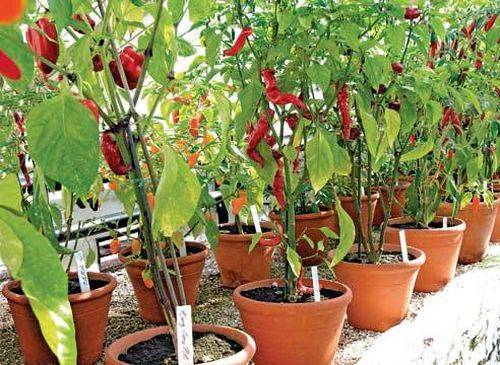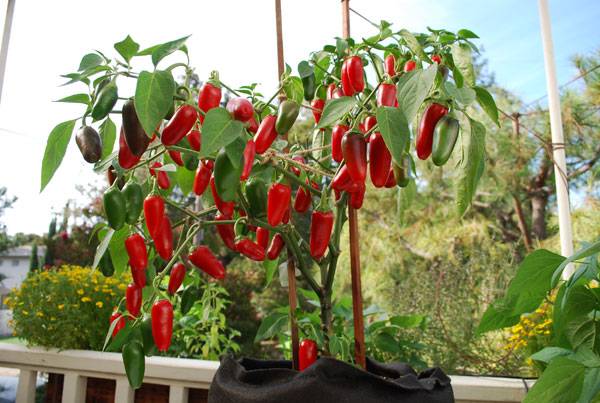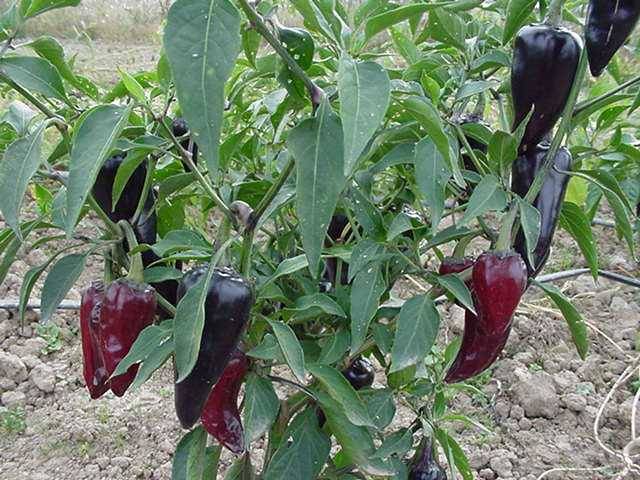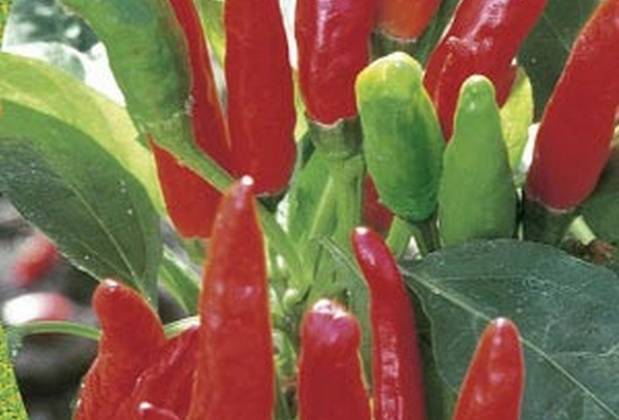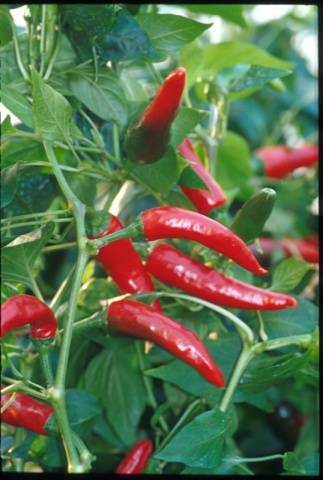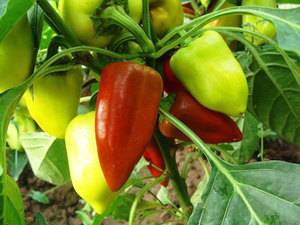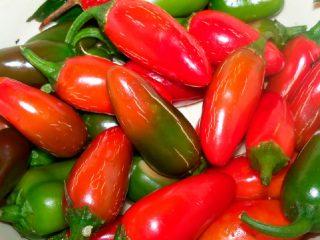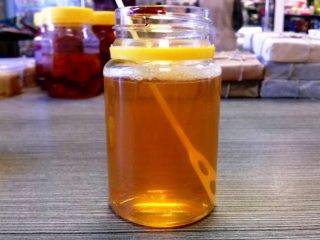In principle, growing peppers on an insulated balcony does not differ from growing them in a room. on the windowsill... If the balcony is open, it's like growing them in a garden bed. Only you don't have to go anywhere.
A significant advantage of growing peppers on the balcony is the larger area compared to the windowsill. This allows you to grow both taller bushes and varieties of peppers with much larger fruits on the balcony. Including sweet varieties.
In fact, if the balcony is not insulated, then the peppers are not grown on it, but transferred from the room in May.
Sweet peppers become bitter when cross-pollinated. Therefore, pepper lovers will have to choose which varieties to grow.
From hot peppers, in addition to many decorative varieties, those that are defined as garden ones can be grown on the balcony. They are not as beautiful as decorative ones, but they often have higher yields. Garden pepper bushes are often larger and taller than ornamental peppers, so they will need a larger pot. If one and a half liters are enough for decorative, then larger varieties will need about twelve. It will look something like this.
Pepper can only be grown on the balcony in summer, but in this case it can be considered an annual plant.
Hot peppers for the balcony
Hungarian yellow
A striking example of pepper, which does not look very decorative in an apartment, but is well suited for growing on a balcony. The variety is very popular all over the world.
The variety bears large, long fruits weighing up to sixty grams. You can pick yellow and red fruits. If desired, from red ripe fruits, you can leave seeds for sowing next year. The fruits are used in cooking and conservation.
The variety is cold-resistant early maturing. Three months are enough to get fruit. The bush is up to fifty centimeters high, compact.
Growing and care
Seeds are sown from the end of February. If the seedlings were sown in a common box, they dive at the stage of the second - third leaf, immediately planting them in a permanent pot. The optimum temperature for growing seedlings is twenty-seven degrees during the day and thirteen at night. They take out to the balcony after the frost ends. Each region has its own term, depending on the latitude and weather conditions of a particular year.
Peppers are planted in fertile soil rich in organic matter.
This variety of pepper requires low air humidity and good moisture in the earthy coma. Pour warm water under the root after sunset.
During the day, plants "sleep" without absorbing moisture from the soil. Pepper is no exception.
The variety requires phosphorus-potassium fertilization during fruit setting and nitrogen fertilization during the growing season. For the better development of the root system and its supply with oxygen, it is necessary to loosen the soil. To increase yields, you can remove the central flower from the first branch.
This pepper is harvested from July to September.
Jalapeno
The original spelling of the variety is Jalapeno. It comes from Mexico, where the population speaks Spanish. In Runet, you can sometimes find a distorted anglicized reading of this name: Jalapeno.In Spanish, "J" reads "X".
In fact, Jalapenos are a group of varieties that differ in fruit color and shape, early maturity and pungency. In general, the entire group belongs to varieties of medium heat. Peppers with large, dense fruits. The color ranges from magenta to red.
Jalapeno orange
The average seed germination time is two weeks. Fruits up to eight centimeters long. Fruiting begins fourteen weeks after planting and continues throughout the season: from July to September.
The seeds are sown to a depth of six millimeters in pots ten centimeters high. Transplantation to a permanent place is carried out after the seedlings reach a growth of ten centimeters and the appearance of at least two pairs of true leaves.
The pungency of the variety is 2.5 - 9 thousand units.
Jalapeno early
An early ripe variety with large (up to eight centimeters) thick-walled fruits in the shape of a blunt cone. Pungency is 8 thousand units. Agrotechnology is similar to the Jalapeno orange variety.
Jalapeno purple
Jalapeno Purpl may be mistakenly called purple. It has dense, fleshy purple fruits with a pungency level of 2.5 to 8 thousand units. The peppers are large. They are used in cooking.
Jalapeno yellow
An early ripe variety with large yellow fruits. As it ripens, the fruits of this variety change color from green to yellow. You can still harvest the fruits green. Fruiting eight weeks after transplanting into a large pot. Pungency 2.5 - 10 thousand units.
Agrotechnology is the same for all Jalapenos varieties.
Magic bouquet
The variety got its name for its characteristic feature: the fruits are collected in bunches of five to ten pieces and are directed upwards. Medium early variety. The bush is up to seventy-five centimeters high. The fruits are thin. The fruit is ten centimeters long and weighs ten to fifteen grams. Ripe red pods. You can also collect green. They are used in cooking, conservation, and medicine.
Fiery volcano
The variety is early maturing. The bush is up to 120 centimeters high, which is not very convenient on a small balcony. The advantage of the variety is its high yield. The fruits are large and familiar to gardeners of the former Soviet Union. They can reach a length of twenty centimeters and a weight of twenty-five grams. Ripe red peppers. Used in cooking, preservation, for the preparation of seasonings.
Sweet peppers
Recommended sweet varieties for growing on the balcony:
Maykop 470
High-yielding mid-season variety. The fruits are large. The height of the bush is up to forty-five centimeters. Peppers are tetrahedral, blunt-pointed. At the stage of full maturity, red.
Winnie the Pooh
Early maturing variety. The bush is low, up to thirty centimeters high. Fruits are conical, weighing up to sixty grams. Differs in a friendly harvest, which is removed in July - August. The color of ripe peppers is red. Stored well. They are distinguished by tender, sweet pulp.
Growing
Seeds are soaked before sowing, after which they are sown in seedling boxes or pots to a depth of half a centimeter. Seedlings appear after two weeks. Seedlings are planted in large pots at the age of eight to ten weeks. If, when planting in the garden, you need to pay attention to the weather conditions, then when growing on the balcony, the seedlings can be safely transplanted into permanent pots at a convenient time. And take out the pepper to the balcony when the weather is warm.
Mysterious Island
Early ripe. The bush is up to sixty centimeters high, compact. Small fruits, directed upwards, grow in bouquets of several pieces. The shape is conical. Length up to nine centimeters. Purple at the stage of technical maturity and red at the stage of biological maturity, the fruits look very decorative against the background of green leaves. Differs in long-term fruiting and high adaptability to environmental conditions. It can grow not only on balconies, but also in offices.
Agrotechnics
Since the cultivation of bitter and sweet varieties is the same, it makes no sense to consider them separately.
Pepper seeds for seedlings are sown starting from the last days of February. Sowing is finished in early March. The dates can only be shifted if you want to get the harvest in the spring. But in this case, the pepper must be grown in the house most of the time, since its development will take place in the coldest part of the year.
Sowing seeds is carried out in a prepared fertile mixture, consisting of humus, low-lying peat, compost, sod land. The recipes for the mixture may be different, there should be one thing in common: the acidity is not lower than 6.5.
Seeds are sown either in boxes or in planting pots. In the case of sowing in a box, seedlings are dived not earlier than the appearance of the second pair of true leaves.
When sown in pots, young peppers are transplanted into a larger permanent pot at eight weeks of age.
Peppers are taken out to the balcony when warm weather sets in.
Both when growing seedlings and with further care, it is necessary to ensure that the earthen lump is always slightly damp.
There is no need to peep the balcony peppers.
